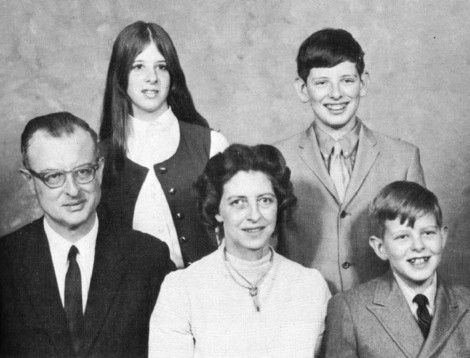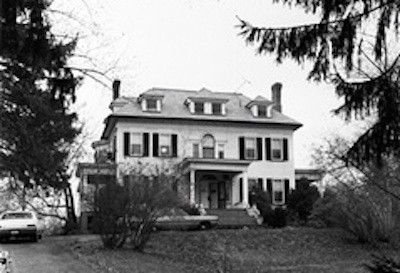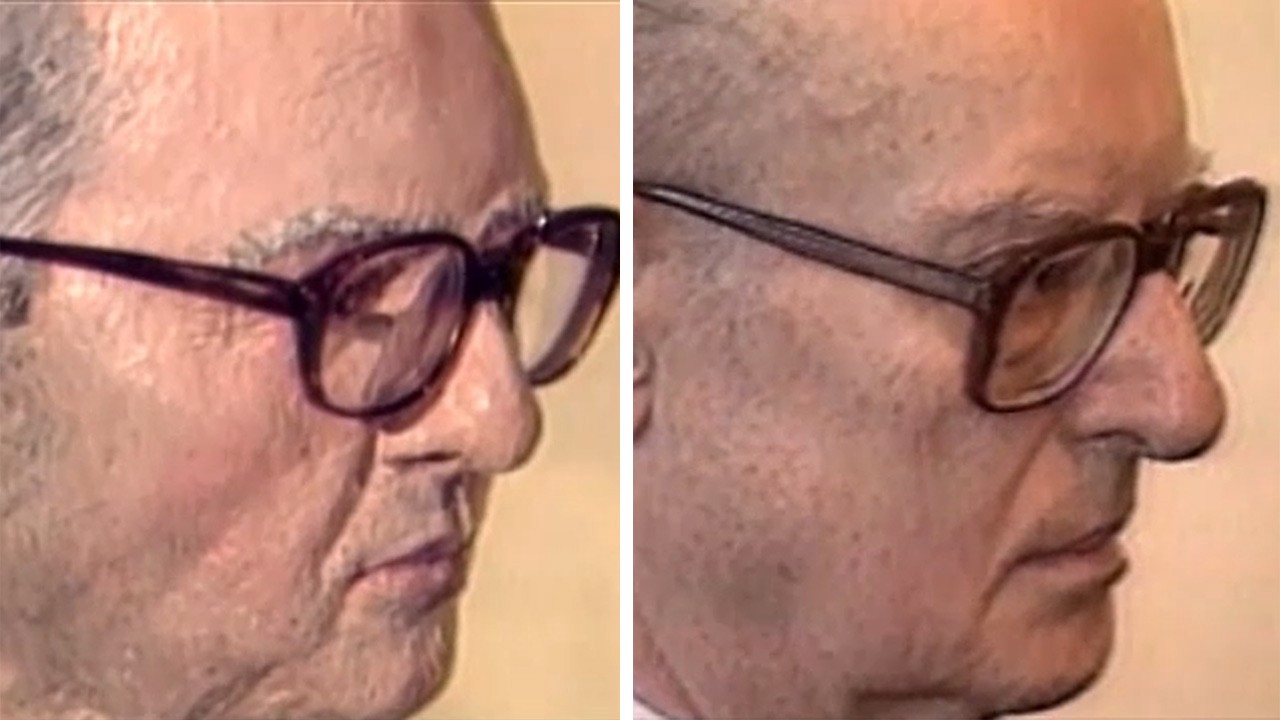 The Lists
The Lists
Nov. 9, 1971, Westfield, New Jersey:
46-year-old accountant John List woke up with his children ? 13-year-old Frederick, 15-year-old John Jr., and 16-year-old Patricia ? just like he did every morning. He sat with them while they ate their breakfast, being careful not to do anything that might make them suspicious. The whole point of his plan, which he had been working on for months, was that his family wouldn?t suffer.
Things had always been strained in the List family, at least to John. He had met Helen, who was a widow, after college. Soon after they began dating, she told him she was pregnant, so John, a devout Lutheran, agreed to marry her. However, after the wedding she revealed that she had not been pregnant after all. John felt, rightly, that he had been tricked, but his religious beliefs would not allow him to break his marriage vows. And while Helen might not have been pregnant before they were married, she wasted no time in getting that way. Within four years, Helen and John had three children.
This put immense pressure on John to provide for his family, but he couldn?t seem to hold down a job. While the quality of his work was never an issue ? he was meticulous and hard-working ? he was often let go because he just rubbed his bosses or coworkers the wrong way. Something about John List was off-putting in a way that was hard to pin down.
So when he landed a job as a vice president of a bank in New Jersey, it seemed their problems were over. Helen insisted that John purchase her dream home ? a sprawling 19-room mansion named Breeze Knoll that was the most expensive house in the most expensive part of town. They couldn?t really afford such an extravagant place, but rather than risk a confrontation, John went to his mother, Alma, to ask for a loan.
While John?s late father had been the more traditional, distant type, John and his mother were always close. Friends said Alma doted on her only child. So she lent him the money he needed, and in exchange, she got to live in a self-contained apartment on the third floor of the mansion. That had been six years ago.
Since then, everything had gone downhill. In less than a year, he was fired from the bank job ? again, due to personality clashes. Rather than tell his family what had happened (and admit failure), he continued to get dressed and go to ?work? every day. He would drive to the train station and ride it a few stops, get off, and return on a different train. He did eventually find another, lower-paying job, which he also lost, and another, and another. His income was not keeping pace with his expenses, and he had begun skimming money from his mother?s accounts. By 1971, he was bankrupt. This presented a deep moral crisis for the devout Lutheran, who believed that poverty itself was a sin.
On top of that, he had three teenagers who were, in his mind, turning more towards the sinful culture of 1970s America. He was particularly worried about Patricia: she had expressed a desire to go into acting, which, John believed, was an especially corrupt profession. There were even rumors she was dabbling in Witchcraft and experimenting with marijuana.
But that was not even the worst thing tearing the List family apart. Helen?s health was deteriorating rapidly, thanks to a terrible secret she had hidden from John for years. Not long after they moved to New Jersey, she began experiencing blackouts and falling down. The vision in her right eye was going. She was drinking heavily and had become dependent on tranquilizers. In the winter of 1968?69, tests revealed she had tertiary syphilis, which she had contracted from her first husband. To make matters worse, Helen, either from embarrassment or mental instability, had stopped going to church.
John had been silently churning all of this around in his mind for months. Going bankrupt was inevitable. However, this would put the family in poverty, dependent on charity and welfare ? a completely unacceptable option, according to John.
He had considered taking his own life. But in his religion, suicide was the one unforgivable sin. As much as he resented his family for the burden they placed on him, he did, in his way, love them. He wanted to know that he would at least have a chance of seeing them again on the other side.
He was determined that there was only one way to save his family from the humiliation and sinfulness of poverty. Much like he did everything in life, he had worked out a plan in meticulous detail.
Once the children left for school, Helen woke up and came downstairs for her customary morning coffee. John made a little chit-chat with her, then came up behind her with the 9mm Steyr automatic pistol his father had given him.
He shot her once in the side of her head, killing her instantly.
He placed her body on a sleeping bag and dragged her into the grand ballroom where he laid her out beneath the stained-glass ceiling. Then he went upstairs to his 84-year-old mother?s apartment.
Alma was fixing her own breakfast; John, ?feeling like a Judas,? gave her a kiss. She asked him about the noise she had heard downstairs. John gave a vague non-answer. He then put the gun to her left temple and pulled the trigger.
Her body was too heavy for him to drag all the way to the ballroom, so he tossed a towel over her face and left her on the floor where she had fallen.
Back downstairs, he cleaned up the ?surprising? amount of blood in the kitchen. Then he proceeded with the next steps of his dark plan: he wrote letters and made phone calls to his kids? teachers, his boss, and others, stating the family had to leave to go tend to a sick relative in North Carolina. Then he went to the post office to mail the letters and stop mail delivery. He also arranged to stop their milk and newspaper deliveries. Finally, he dropped by the bank and cashed in his mother?s $2,000 savings bond.
Back at Breeze Knoll, he made himself a sandwich and waited for his children to come home. Patricia was the first ? she called and told her father she was feeling ill, so John picked her up from school early. Once they were inside, John shot her in the jaw with his antique .22 pistol, a souvenir he had kept from his time in the war. He then dragged her body into the ballroom and laid her out near her mother.
Next home was Fred. John shot him the same way he had the others, and laid his body out next to Patricia.
John Jr. had a soccer game after school that day. John Sr. drove to the field and watched him play, then gave him a ride home. Once inside the kitchen, John Sr. shot him in the back of the head. But unlike the other members of the List family who dropped instantly, John Jr. struggled. John Sr. shot him nine more times before dragging him into the ballroom with the rest of his family.
He then said a prayer from the Lutheran hymnal over their bodies.
John cleaned up the blood as best as he could, then sat down at the table and ate dinner. When he was done, he washed his dishes and set them to dry in the drainer. He went to bed and slept, as he later admitted, better than he had in years.
The next morning, he turned down the air conditioning to preserve the bodies. He turned on every light in the house and turned the radio on to his favorite classical music station, hoping to trick any would-be intruders into thinking there were people in the home.
He then sat down and penned a five-page confession letter to his pastor. Finally, he searched out every family picture in the house and cut his image out of them.
Then John Emil List walked out the door and locked it behind him.
He drove to John F. Kennedy International Airport and dropped his car off, then took a bus back into the city. From there, he took a train to Denver. There, he applied for a Social Security card under the name of Robert Peter Clark. He got a job as a short-order cook and started his new life.
Meanwhile Breeze Knoll sat still, empty of all life. As the weeks passed, the lights began to burn out, one by one, leaving the mansion dark, only the sound of classical music playing over the speakers.
 Breeze Knoll as it was in 1971
Breeze Knoll as it was in 1971
Because the Lists were so reclusive, it took nearly a month before anyone started asking questions. By the first week of December, Patricia?s drama teacher was concerned about her prolonged absence. He said he couldn?t shake the feeling that something was terribly wrong at the List home. He found John List to be a strange man, but it was something that Patricia had confided in him earlier that worried him. She had told him that she was worried her father was going to kill the whole family.
The drama teacher convinced another teacher to go with him to the List home to check on them.
Seeing strange people walking around the house and peering in the windows in the dark, some neighbors called the police. Officers George Zhelesnik and Charles Haller were first to arrive.
The officers knocked and looked through the windows, but couldn?t find anything out of place. At the neighbors? urging, they found an unlocked window and climbed through.
The house was almost entirely dark, except for a single upstairs light that threw long shadows over everything. The air inside was frigid. And creepiest of all, haunting, funereal music was playing throughout the house.
Following their flashlights through the cold, empty home, they came to a set of curtains partitioning off the ballroom. As soon as the officers parted the curtains, they were hit with the smell of human decomposition.
Inside, neatly laid out on sleeping bags on the floor, were the bodies of Helen, Patricia, Frederick, and John Jr.
Upon searching the rest of the house, they found John?s confession letter and the guns he had used to kill them. Following the instructions in the letter, they found Alma?s body upstairs.
They immediately put out a nationwide APB for List. Soon, they found his car parked at John F. Kennedy Airport, but could find no record of his taking a flight. There were no more leads, no clues as to where List might have gone.
John List was in the wind.
The following August, the List home caught fire in what was widely believed to have been an arson. Afterwards, it was discovered that the stained-glass ceiling in the ballroom was signed by Louis Comfort Tiffany, making it worth upwards of $100,000 ? enough to have solved all the Lists? money problems with plenty left over.
Over the years, the police followed up on every tip, sighting, and lead. But they all led nowhere. The police and press did their best to keep the case in the public eye, publishing and broadcasting the story on every significant anniversary: the first, the third, the fifth, the tenth. They even tried to get the case featured on Unsolved Mysteries, to no avail.
By 1989, the List case was nearly 18 years cold. Another TV show called America?s Most Wanted had been on the air for a little over a year, and was already a hit for the Fox network. Captain Frank Marranca of the Union County Prosecutor?s Office thought this would be the perfect vehicle to get the List case out to a wider audience, and, hopefully, bring John List to justice. However, the show initially turned them down ? the case was ?too old, too cold.?
Until John Walsh caught wind of the case. Some of you may only know Walsh as a true-crime TV host who occasionally opines on Twitter. But Walsh got his start in true-crime TV hosting AMW in 1988, thanks to his victims?-rights advocacy following the murder of his 6-year-old son, Adam.
Walsh, understandably, has some pretty strong feelings about List. He?s called him a ?son of a bitch,? a ?coward,? and a ?child-killer.? Walsh was determined to bring List to justice, but they needed an image of him as he would have looked in 1989.
So Walsh called on forensic sculptor Frank Bender to create an age-progressed bust of List. In addition to using the standard facial-reconstruction measurements that most forensic anthropologists use, he also reached out to forensic psychologist Richard Walter to get a detailed psychological profile of List. He also looked at pictures of List?s parents to see how their faces had aged. Using all that information, along with his own intuition, he created a bust of what List, now in his 60s, would look like.
But it would not be complete without his glasses. Knowing List?s personality, Bender scoured thrift stores to find just the right frames that someone like List would likely wear ? conservative, with thick black frames. Once he found the pair he thought would be a good fit, the bust was finished.
 Frank Bender?s forensic bust, left, and the real John List, right.
Frank Bender?s forensic bust, left, and the real John List, right.
The case of John List aired on AMW May 21, 1989. An estimated 22 million people saw the program, including true-crime fans Wanda Flanery and her daughter Eva Mitchell in Denver. Even before the bust was shown, Flanery and Mitchell were sure their former neighbor, Bob Clark, fit the description: soft-spoken, always wears a suit, an accountant, a devout Lutheran. When Bender?s forensic bust was shown on screen, they were stunned. It looked just like Clark, right down to the glasses. So Flanery called the tip line.
Eleven days later, the FBI showed up at ?Bob Clark?s? home in Richmond, Virginia. His new wife, Delores, told them that he was at work. So the agents showed up at the office where ?Clark? was working as an accountant. One of the agents said it was striking how much he looked like Bender?s sculpture.
They asked him if he was Bob Clark, and he said yes. They then asked if he was John List. He denied it. He continued to deny it even after his prints were found to be a match to the prints taken from List when he?d applied for a handgun permit.
List was arrested and charged with five counts of first-degree murder. His trial began April 2, 1990?18 and a half years after the killings.
List was diagnosed by the court psychiatrists with Obsessive-Compulsive Disorder, which his defense said made him only guilty of second-degree murder.
On April 11, after nine hours of deliberation, the jury found him guilty on all five counts of first-degree murder. He was given the maximum sentence allowed at the time: five consecutive life terms. When his sentence was read aloud, the courtroom erupted in applause.
One person, however, wasn?t as happy with the verdict: Walsh. He wanted List to get the death penalty.
Many in law enforcement ? along with Walsh ? credit Bender?s amazingly accurate bust with cracking one of the oldest cases at the time. In fact, Walsh kept that bust in his office for many years. Bender, sadly, passed away in 2011 from mesothelioma.
List later appealed his case, claiming he had been suffering from PTSD from his combat experience in WWII. But a federal appeals court rejected his claims.
At this point, any speculation about his mental state is moot, but I would like to put forward a theory I haven?t seen discussed yet: I believe John List was on the Autism spectrum.
Let me be clear on two points. First, the vast majority of people on the spectrum are non-violent, so I am not saying Autism made him homicidal. Second, being on the spectrum still would not excuse or justify what he did.
Why do I think he was on the spectrum? Look at what his co-workers and neighbors said about him: he was a hard worker, focused, and meticulous ? traits commonly found in people on the spectrum.
He was soft-spoken, polite, and pathologically avoided conflict, yet he seemed ?strange,? ?odd,? and ?off-putting.? This sounds very much like someone on the spectrum; their odd behaviors and seeming lack of social skills are probably the most well-known symptoms of the disorder.
The fact that he was diagnosed with OCD even fits with that: the symptoms of OCD and Autism are so similar that they are commonly indistinguishable even to doctors and psychiatrists.
But it was watching his interviews that convinced me. Before speaking to psychiatrists, police, or television hosts, he would carefully, even fussily, arrange any items on the table. Everything had to be just so. His manner seemed flat and emotionless, his tone of voice barely changing. Having raised a son on the spectrum, it was striking to me how closely he fit the profile.
But this is all speculation. We?ll never know what truly went on in his mind; List died in prison on March 21, 2008, from pneumonia. He was 82.


